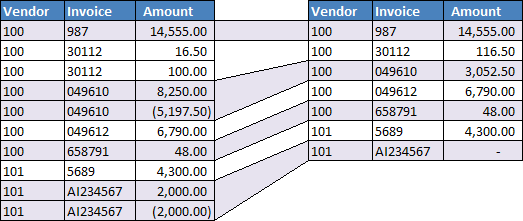In this step, you may summarize results in order to show fewer rows of information that contain aggregate values in specific columns.
In the following example, three columns of data are being queried from a transaction table. There may be more than one transaction for each invoice which causes more than one row of data to be displayed in some cases for a given invoice. This step of the wizard would allow you to reduce these results to one row per invoice where the amount column displays the sum of the transactions for each invoice.
| Before Summarizing | After Summarizing | |
 | ||
Use the toolbar at the top of the window to enable or disable summarization and to control how values are summarized:
In the example above, the Vendor and Invoice columns would be marked None and the Amount column would be marked Sum.
Summarize
(checkbox)Check this box to allow the results to be summarized.
For each column to be displayed by your query, select one of the following options:
| | Values will not be summarized. This means that each distinct value will appear in the results. The columns that are not being summarized determine the level of detail that will be shown in the results. Marking more columns as None will typically result in more rows. Marking fewer rows as None will typically result in fewer rows. |
| | Values will be added together to produce a sum. |
| | The average value will be shown. |
| | The largest value will be shown. |
| | The smallest value will be shown. |
Note - Using this feature produces a GROUP BY clause in the underlying SQL statement and adds the appropriate aggregate functions to columns in the SELECT clause.